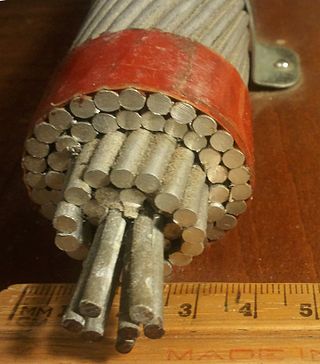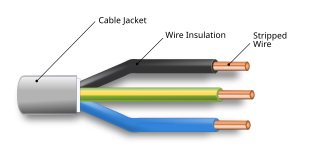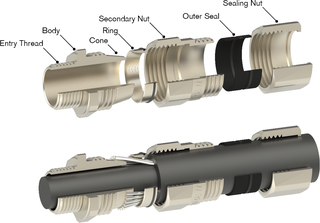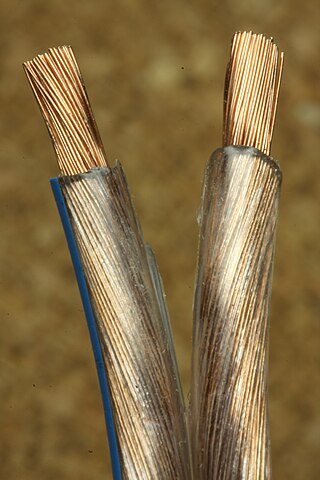Related Research Articles

A wire is a flexible strand of metal.

An electrical cable is an assembly of one or more wires running side by side or bundled, which is used as an electrical conductor, i.e., to carry electric current. One or more electrical cables and their corresponding connectors may be formed into a cable assembly, which is not necessarily suitable for connecting two devices but can be a partial product. Cable assemblies can also take the form of a cable tree or cable harness, used to connect many terminals together.

Coaxial cable, or coax, is a type of electrical cable consisting of an inner conductor surrounded by a concentric conducting shield, with the two separated by a dielectric ; many coaxial cables also have a protective outer sheath or jacket. The term coaxial refers to the inner conductor and the outer shield sharing a geometric axis.
In electricity supply design, a ring circuit is an electrical wiring technique in which sockets and the distribution point are connected in a ring. It is contrasted with the usual radial circuit, in which sockets and the distribution point are connected in a line with the distribution point at one end.

Electrical wiring is an electrical installation of cabling and associated devices such as switches, distribution boards, sockets, and light fittings in a structure.
Electrical wiring in the United Kingdom is commonly understood to be an electrical installation for operation by end users within domestic, commercial, industrial, and other buildings, and also in special installations and locations, such as marinas or caravan parks. It does not normally cover the transmission or distribution of electricity to them.

A power cable is an electrical cable, an assembly of one or more electrical conductors, usually held together with an overall sheath. The assembly is used for transmission of electrical power. Power cables may be installed as permanent wiring within buildings, buried in the ground, run overhead, or exposed. Power cables that are bundled inside thermoplastic sheathing and that are intended to be run inside a building are known as NM-B.
British Standard BS 7671 "Requirements for Electrical Installations. IET Wiring Regulations", informally called in the UK electrical community "The Regs", is the national standard in the United Kingdom for electrical installation and the safety of electrical wiring in domestic, commercial, industrial, and other buildings, also in special installations and locations, such as marinas or caravan parks and medical locations
IEC 60364Electrical Installations for Buildings is the International Electrotechnical Commission (IEC)'s international standard on electrical installations of buildings. This standard is an attempt to harmonize national wiring standards in an IEC standard and is published in the European Union by CENELEC as "HD 60364". The latest versions of many European wiring regulations follow the section structure of IEC 60364 very closely, but contain additional language to cater for historic national practice and to simplify field use and determination of compliance by electricians and inspectors. National codes and site guides are meant to attain the common objectives of IEC 60364, and provide rules in a form that allows for guidance of persons installing and inspecting electrical systems.

Mineral-insulated copper-clad cable is a variety of electrical cable made from copper conductors inside a copper sheath, insulated by inorganic magnesium oxide powder. The name is often abbreviated to MICC or MI cable, and colloquially known as pyro. A similar product sheathed with metals other than copper is called mineral insulated metal sheathed (MIMS) cable.
A thermoplastic-sheathed cable (TPS) consists of a toughened outer sheath of polyvinyl chloride (PVC) thermoplastic, covering one or more individual annealed copper conductors, themselves insulated with PVC. This type of wiring is commonly used for residential and light commercial construction in many countries. The flat version of the cable, with two insulated conductors and an uninsulated earth conductor, is referred to as twin and earth. In mainland Europe, a round equivalent is more common.

A multicore cable is a type of electrical cable that combines multiple signals or power feeds into a single jacketed cable. The term is normally only used in relation to a cable that has more cores than commonly encountered. Not all cables with multiple insulated conductors are called multicore cables – the core in multicore refers to the number of usable connections made, not the number of conductors or wires. In most cases, a "usable connection" requires multiple conductors, such as the positive and negative conductors used for DC power.

Twin and earth cable is a colloquial name in the UK, Australia, New Zealand and other countries for a type of flat sheathed fixed mains electricity cable, containing two insulated current-carrying conductors and an Earth connector. In Australia and New Zealand this type of cable is referred to as 'Flat TPS', as well as "Twin and Earth" or "Twin with Earth".
In electrical power distribution, armoured cable usually means steel wire armoured cable (SWA) which is a hard-wearing power cable designed for the supply of mains electricity. It is one of a number of armoured electrical cables – which include 11 kV Cable and 33 kV Cable – and is found in underground systems, power networks and cable ducting.
Tri-rated cable is a high temperature, flame retardant electrical wire designed for use inside electrical equipment.

A high-voltage cable is a cable used for electric power transmission at high voltage. A cable includes a conductor and insulation. Cables are considered to be fully insulated. This means that they have a fully rated insulation system that will consist of insulation, semi-con layers, and a metallic shield. This is in contrast to an overhead line, which may include insulation but not fully rated for operating voltage. High-voltage cables of differing types have a variety of applications in instruments, ignition systems, and alternating current (AC) and direct current (DC) power transmission. In all applications, the insulation of the cable must not deteriorate due to the high-voltage stress, ozone produced by electric discharges in air, or tracking. The cable system must prevent contact of the high-voltage conductor with other objects or persons, and must contain and control leakage current. Cable joints and terminals must be designed to control the high-voltage stress to prevent the breakdown of the insulation.

A cable gland is a device designed to attach and secure the end of an electrical cable to the equipment. A cable gland provides strain-relief and connects by a means suitable for the type and description of cable for which it is designed—including provision for making electrical connection to the armour or braid and lead or aluminium sheath of the cable, if any. Cable glands may also be used for sealing cables passing through bulkheads or gland plates. Cable glands are mostly used for cables with diameters between 1 mm and 75 mm.

Copper has been used in electrical wiring since the invention of the electromagnet and the telegraph in the 1820s. The invention of the telephone in 1876 created further demand for copper wire as an electrical conductor.

An electrical conduit is a tube used to protect and route electrical wiring in a building or structure. Electrical conduit may be made of metal, plastic, fiber, or fired clay. Most conduit is rigid, but flexible conduit is used for some purposes.
References
- ↑ "Flexible Control Cables". helukabel.co.uk. Archived from the original on 14 March 2019. Retrieved 12 March 2019.
- ↑ SY Control Cable specification
- ↑ "Should SY, YY and CY cables be used in electrical installations?". Voltimum UK. 5 December 2017. Retrieved 30 December 2018.
- ↑ "Sy-yy-cy-cable". www.whyprysmian.co.uk.
- ↑ "CENELEC". cenelec.eu. Archived from the original on 2011-01-01. Retrieved 30 December 2018.